Although I can trace my family to the early formation of America, our ethnic experience was not as recorded or valued the same as the traditional accounts of the early American experience. As a person of African heritage, I had to depend upon my own ancestral accounts to help me understand what America was like for people representing minority racial, religious, and ethnic history. I am thankful to have many primary documents and heirlooms that recount my American story.
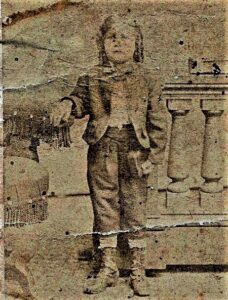
Richard Gill Forrester – age 5
One story I most cherish is about my then thirteen-year-old great grandfather, Richard Gill Forrester, the grandson of a prominent Richmond, Virginia Jewish attorney, and a free woman of color, who rescued our country’s flag. This story has helped me to understand the significance of the American flag, and why it continues to be a symbol of hope for all Americans. For that reason, I tell this story every year for Flag Day.
Virginia’s ordinance of secession was ratified on May 23, 1861. Shortly after, the newly constituted Confederate Congress would declare Richmond as the new headquarters of the Confederate States of America. The announcement drew wild celebration on the capitol grounds that was thronged with thousands of rebel revelers. As the federal flag was struck down from atop the capitol building and thrown into the rubbish to be later burned, Richard Forrester a page at the capitol, amid the chaos of celebration, rolled the flag into a bundle and carried it to his home a short distance away on College Street. Once home, unknown to his own family, he placed the flag under his bedding, where he would sleep on it nightly for the entire four years of the war. The risk he took rescuing and preserving what was seen by nearly all Southerners at the time, as the symbol of Northern aggression and invasion, was significant.
The city scene on an early morning in April 1865 was one of turmoil. As fires raged across the city, streets were crowded with people, black and white, enslaved, and free, looting stores and warehouses that were wrecked and abandoned with the approach of Union troops. Some accounts reported that barrels of liquor had been emptied into the streets, the more reckless drinking the running spirits directly from the gutters. In all the fire, smoke, and confusion, Richard dashed across onto the capitol grounds and made his way up the spiral staircase that led to the roof of the Confederate capitol. There and then, he replaced Old Glory in advance of arriving Union troops.
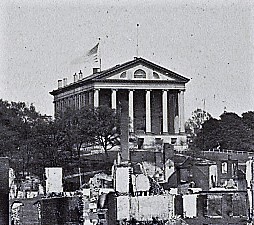 Fighting a civil war over issues of states’ rights and slavery, the war ripped our country in two and claimed the lives of over six hundred thousand combatants. On the morning of April 2, 1865, after four long years of bloodshed, the Union army had its sites on Richmond, Virginia, the capitol of the Confederate States of America. As southern soldiers, officials and sympathizers abandoned Richmond to advancing Union forces on that early morning in 1865, retreating Confederate soldiers set fire to grain and tobacco warehouses. The blaze spread quickly and left a significant part of the city in ruins. Through the chaos of evacuations, sporadic skirmishes, and raging fire, one of the first of many Union troops to enter Richmond included a company of men with the Thirteenth New Hampshire Regiment. The memoirs of the regiment have been compiled and published in the “Thirteenth Regiment of the New Hampshire Volunteers in the War of the Rebellion” by S. Millet Thompson, an officer with the regiment. Thompson provides a vivid and detailed account of the events of the fall of the Confederate capitol:
Fighting a civil war over issues of states’ rights and slavery, the war ripped our country in two and claimed the lives of over six hundred thousand combatants. On the morning of April 2, 1865, after four long years of bloodshed, the Union army had its sites on Richmond, Virginia, the capitol of the Confederate States of America. As southern soldiers, officials and sympathizers abandoned Richmond to advancing Union forces on that early morning in 1865, retreating Confederate soldiers set fire to grain and tobacco warehouses. The blaze spread quickly and left a significant part of the city in ruins. Through the chaos of evacuations, sporadic skirmishes, and raging fire, one of the first of many Union troops to enter Richmond included a company of men with the Thirteenth New Hampshire Regiment. The memoirs of the regiment have been compiled and published in the “Thirteenth Regiment of the New Hampshire Volunteers in the War of the Rebellion” by S. Millet Thompson, an officer with the regiment. Thompson provides a vivid and detailed account of the events of the fall of the Confederate capitol:
“… There was no flag on the roof of the capitol when I entered the grounds, but within a few minutes it suddenly appeared on the flagstaff on the roof, and immediately afterward I had a conversation with the man who raised it. He was a light-colored boy named Richard G. Forrester, living on the corner of College and Marshall. 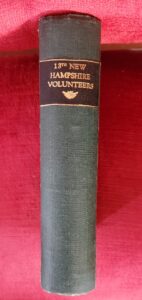 When the State of Virginia passed the ordinance of secession, he was a page or errand boy employed in the capitol. The secessionists tore down the flag and threw it among some rubbish in the eaves at the top of the building. At the first convenient opportunity, he rolled the flag in a bundle, carried it to his home and placed it in his bed, where he slept on it nightly since that time. This morning, he said, as soon as he dared after the Confederates had left the city, he drew the old flag from its hiding place, ran to the capitol with it, mounted to the top and ran the flag up the flagstaff. This was the first flag hoisted in Richmond after its evacuation by the Confederates.”
When the State of Virginia passed the ordinance of secession, he was a page or errand boy employed in the capitol. The secessionists tore down the flag and threw it among some rubbish in the eaves at the top of the building. At the first convenient opportunity, he rolled the flag in a bundle, carried it to his home and placed it in his bed, where he slept on it nightly since that time. This morning, he said, as soon as he dared after the Confederates had left the city, he drew the old flag from its hiding place, ran to the capitol with it, mounted to the top and ran the flag up the flagstaff. This was the first flag hoisted in Richmond after its evacuation by the Confederates.”
After the war, Forrester was appointed to a coveted federal position with the United States Post Office Department during the Reconstruction era Richmond. He later moved north to New York City with his young family and took a position with the New York and New Haven Railroad, frequently summering in Newport, Rhode Island the historic home of his Jewish ancestors and where his beloved family members who helped raise him were buried. He lived a full and active life and was laid to rest at the historic Island Cemetery in Newport on Nov. 15, 1909, with military honors by the Lawton and Warren Post No. 5 of the Grand Army of the Republic. His front-page obituary in the New York Age, the leading African-American newspaper of the day, was quoted as saying, “There passed away a soldier who came into prominence by gaining the distinction of being the first man who hoisted the Union flag in Richmond after the Civil War.”
The veterans who buried him honored him as a soldier for his heroic deed. More importantly, why would a young man of color be moved to protect the federal flag that flew over the building that served as the hub of the Confederate States of America? During a time in our country when nearly all persons of African heritage, enslaved and free, North and South were non-citizens, his actions would provide no future guarantee of civil liberties for himself and his family. His daring efforts were well before the 13th, 14th, and 15th Amendments to the United States Constitution and a Civil Rights Act that would not be achieved for another one hundred years of reconstruction and reconciliation before becoming law in 1964.
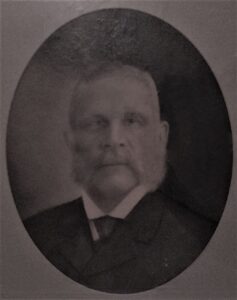
Richard Gill Forrester – age 50
Today, Americans are very attached to our country’s flag. Old Glory is proudly displayed fluttering on front porches, unfurled over our brave veterans’ burial markers and people wrap themselves with the flag as a symbol of protest, often intended to point out America’s unmet ideals of life, liberty, and justice for all. My ancestors have fought in nearly all our country’s wars, beginning with the American Revolution. All of them, those of African, Jewish, Christian, and mixed racial heritage, believed they were fighting for their country, even at a time when many denied them the rights of citizenship. Richard Forrester, then a teenager, embodied their beliefs that they were Americans. They believed that, while not perfect, our country still held the opportunity for them to be recognized as full citizens, under the fundamental principles of our democracy with all the rights and privileges of being American. During one of America’s most tumultuous times, a young Richard Forrester safeguarded the symbol of that belief, our American flag.
- Saving Old Glory - March 31, 2023
- Keith Stokes receives Outstanding Achievement in Leadership Award - December 22, 2022
- Harriet Jacobs - December 22, 2022
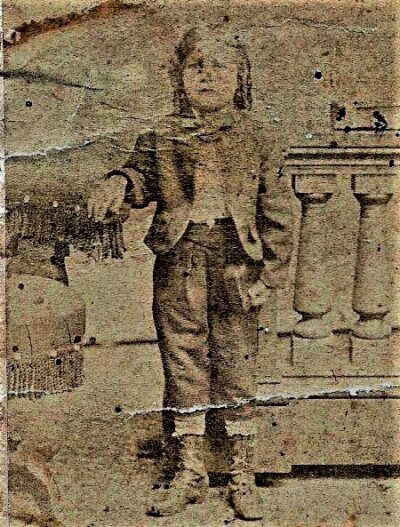


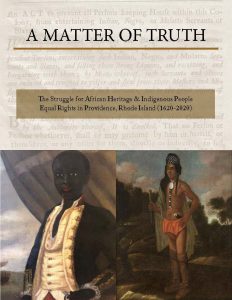 Click on image to view pdf
Click on image to view pdf
June 13, 2020 at 10:11 pm
What a great story. First time I ever heard it but glad you shared it. Now I will share it with some of my friends. Thank you.
June 20, 2020 at 3:49 pm
Thank you. We are happy to share these stories.
August 26, 2020 at 8:41 pm
How I wish Dad had known all of his family history. Where does the Haitian come in. Did October (Robert Barclay) marry? So the ancestor is Mary, Robert’s sister? Still a little confused.
May 17, 2021 at 7:27 pm
Barbara, Robert married Eliza DePee. Her father, Thomas DePee escaped the revolution and immigrated to Philadelphia. Theresa
September 30, 2020 at 6:55 am
Incredible untold story of America, its hopes, dreams and ideals from a perspective few can imagine.
Keith, my son is a young director in California, and I know a number of folks who are major investors in the film industry. Let’s put together an effort to get this story told to the world in way that can uniquely bring this country together. Call me at (401) 749-2732 (I reside in Arizona now.)
January 12, 2021 at 3:34 pm
Always great stories from you, Keith. Thank you so much for them. I look forward to your museum and to walk through history.
January 12, 2021 at 4:31 pm
Very interesting read…thank you for sharing your research.
January 12, 2021 at 7:45 pm
What an incredible and inspiring historical episode in a long and daunting legacy of our country’s struggle for equity. Thank you for sharing these remarkable portraits of bravery and persistence. Neil Corkery